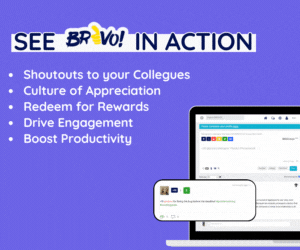
Every organization looking for improved employee performance has a recognition program in place in one form or the other.
Employee appreciation comes with various benefits for employers, including better levels of workplace productivity and engagement. Unfortunately, companies with recognition programs fail to get the most out of it too frequently.
One of the reasons is that businesses often make many blunders while establishing their recognition program, and these mistakes can often have a negative impact rather than a positive one.
We list the top ten common mistakes in regard to employee appreciation here, so you can avoid them and reap the fruits of your endeavors spent on recognizing employees:
1- Companies Lacking Transparency
A company-wide recognition program’s effectiveness depends on its reward system’s fairness and transparency.
Thus, if the system appears to be based on favoritism, the entire process will become skeptical, causing more harm than the intended good.
To avoid this, you can make your employees grasp how the process works and how to be acknowledged.
When everyone understands the entire process, its transparency and equity can no longer be doubted.
2- Ignoring Some Employees

Recognizing and rewarding top achievers can increase the overall workplace morale and drive other workers to work hard. But, at the same, it may demoralize those employees as well who work equally hard but fail to produce results.
As a result, the overall productivity of such employees diminishes. Furthermore, they may add even less effort in the future.
On top of that, people who are left out may feel alienated from the rest of the workforce, which may result in factions among colleagues.
There is a straightforward cure for this kind of issue in nearly all organizations: workers feeling excluded need to be recognized for their contributions even though they are unable to produce the desired results.
3- Failure to State Clearly Defined Goals
The process will be unpredictable if you do not establish clear objectives for your employees to get recognized and rewarded. And so, your employees will be unsure of which parts of their performance to enhance.
Therefore, establish clear goals from the start to offer your workers a direction for performance improvement.
Alternatively, you can define and convey important performance metrics as well.
4- Having Annual Awards Only
You want your employees to be motivated and dedicated all year, right? Then why have your program restricted to annually only? Doing so understandably reduces its usefulness.
Having weekly, bimonthly, or monthly employee appreciation programs makes more sense, allowing you to analyze the program’s effectiveness while keeping staff motivated throughout the year.
5- Rewards Merely Based On Performance
An ideal employee should have integrity, timeliness, and great communication abilities. Employee recognition programs that just promote achievement tend to discourage other attributes in employees as it would imply that these qualities do not matter much.
Encouraging employees to develop desirable attributes will underline their relevance to the organization’s aims and objectives. And using an employee appreciation program, you can foster these traits in your workplace.
6- Rewarding Every Employee the Same Stuff

All your employees work toward the same goal, but it is critical to identify and address their particular characteristics.
Although non-customized gifts can be beneficial, you should invest in custom-based appreciation as it is a more thoughtful way to acknowledge the workforce.
Moreover, when trying to reward employees with tangible rewards, you may want to survey your employees to find out what benefits they prefer and dislike.
In a nutshell, it will make the award more meaningful if you go the extra mile to find out what attracts your employee as an individual more.
Read More: Using Bravo as an Employee Recognition Program
7- Not Sticking To The Program
When a program is put in place, keeping it running smoothly can be challenging after a time.
The negligence in maintaining your program has a negative impact on employee morale and productivity.
As a result, a recognition programs must be evaluated and maintained on an ongoing basis.
Executives should also keep their recognition programs up to date on a regular basis to avoid them becoming obsolete.
After all, the key to sustaining a recognition program is to make adjustments to meet the needs of both new and existing employees.
8- Making It Just About The Money

When it comes to employee recognition, concentrating entirely on monetary compensation may be a bad idea.
If they are working just for the money, you risk losing your top staff to competitors if they are offered a higher salary elsewhere.
Other incentives, such as exclusive movie tickets, family holidays, and meal vouchers, will go a long way toward satisfying your employees.
Importantly, the incentive must be something the employee desires.
9- Inconsistency
Recognition software that is inconsistent is the last thing you want to design.
In fact, it may give your staff the impression that the program is unfair, reducing its effectiveness.
In this regard, regular promotions and ensuring top management’s acknowledgment is constant might help avoid this mistake.
10- No Follow-Up
Implementing a program is one thing, but the dedication of your entire staff to make it succeed is another.
Therefore, while the first step is to develop the program, the second is to keep the follow-ups regarding the program’s results.
Conclusion
Employee recognition programs offer several benefits. When implemented correctly, such programs help a company achieve its goals.
The mistakes discussed in this article are the most common ones that companies commit when it comes to rewarding and recognizing employees. But avoiding them can help you greatly in the long run.
And last, one of the biggest challenges employers encounter in this aspect is maintaining a recognition program. It is due to the workforce being divided into older and younger generations of employees.
Consequently, it may appear difficult to simultaneously address the needs of several generations of employees.
However, to effectively recognize employees from the younger generation, you can use Bravo, an employee recognition that has been specially created for that purpose. Additionally, it also helps take care of the employee experience of employees from the older generation.
By scheduling a completely free demo, you can learn more about Bravo.






